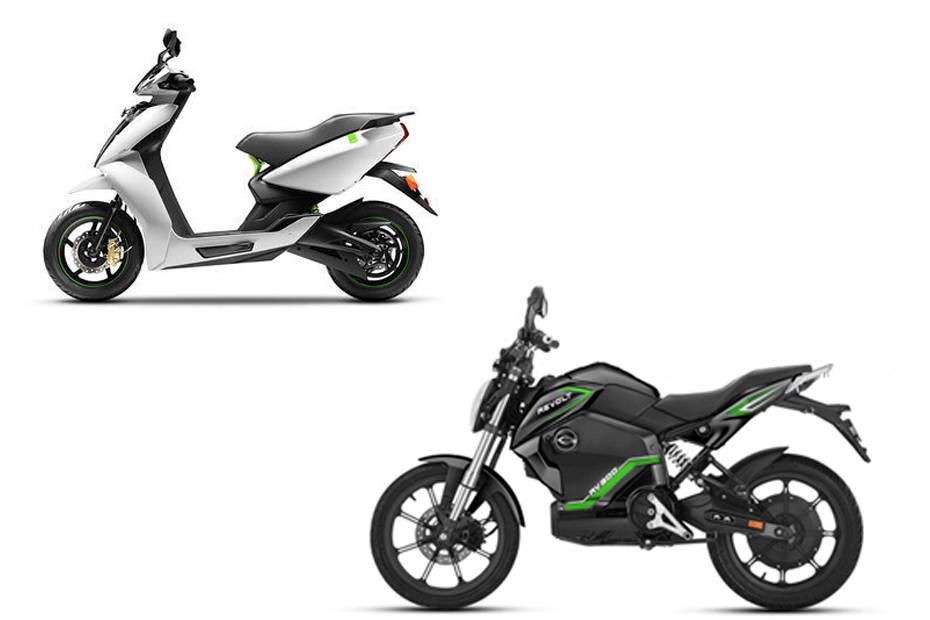Revolt RV300 vs Ather 340: Spec Comparison
Modified On Sep 3, 2019 11:55 AM By Jehan Adil Darukhanawalafor Revolt RV300
- 2836 Views
In this battle of electrics, we pit the two company’s base models.

Looking to change the rules of the game, Revolt launched its RV400 with a unique pricing plan. Not just satisfied with bringing along just a single product, Revolt also launched the RV300, a slightly cheaper electric motorcycle derived from the RV400. Since it is Revolt’s entry point into the brand, we decided to pit it on paper against the more established Ather’s base offering, the 340.

Powertrain:
|
Specifications |
Revolt RV300 |
Ather 340 |
|
Motor |
1.5kW Bosch hub motor |
Brushless DC motor, 2.8kw continuous power with 4.4kw of peak power |
|
Torque |
NA |
20Nm |
|
Kerb weight |
101kg |
111kg |
Unlike the RV400, the RV300 gets a hub motor which powers the bike. It also has a smaller power rating, capping off the top speed at just 65kmph. The Ather 340’s motor is a toned down version of the 450’s unit. But it is the more powerful of the two power units here. Despite weighing 10kg more than the RV300, the Ather 340 has a higher claimed top speed of 70kmph.

Battery:
|
Specifications |
Revolt RV300 |
Ather 340 |
|
Battery type: |
Removable lithium-ion |
Fixed lithium-ion type |
|
Battery capacity |
2.7kWh |
2.71kWh (1.92kWh usable) |
|
Charging time |
0-75% in 3 Hours And 0-100% in 4.2 Hours |
0 - 100%: 5 hours 15 minutes |
|
Fast charging |
NA |
0-80% in 1 hour (1km/minute) |
|
Range |
180km in Eco mode, 110 km in Normal mode and 80km in Sports mode |
60km in Eco mode, 55km in Ride mode and 45km in Sport mode |
Both of these electric motorcycles have a lithium-ion battery pack which provides the necessary fuel for the motor. While the 19kg battery on the RV300 is removable, the Ather uses its batteries as a stressed member of the chassis. The battery rating for both of these products might be the same at 2.7kWh, but the Ather keeps a bit of it in reserve. And while claimed range for both products is quite different, we figure the RV300 to go just a few kilometres extra than the 340.

The RV300 is devoid of fast charging, something which the 340 gets. Pull up to an Ather Grid charging station and you can charge your 340 from naught to 80 per cent in roughly an hour. However, Revolt has a trick up its sleeve. With the removable battery, Revolt has cut down charging time from an hour-long wait to mere minutes, thanks to battery swapping stations.
Underpinnings:
|
Specifications |
Revolt RV300 |
Ather 340 |
|
Frame |
Cradle-type with box-section swingarm |
Hybrid chassis with aluminium and steel |
|
Front suspension |
Inverted fork |
Telescopic fork |
|
Rear suspension |
Monoshock with screw-type preload adjustment |
Progressive monoshock |
|
Front brake |
240mm disc with CBS |
200mm petal disc with CBS |
|
Rear brake |
180mm disc with CBS |
190mm petal disc with CBS |
|
Front tyre |
90/80 - 17 |
90/90 - 12 |
|
Rear tyre |
110/80 - 17 |
90/90 - 12 |
Both of these electric vehicles come with top drawer kit. While there is some form of cost-cutting involved on the RV300 (missing out on the aluminium swingarm from the RV400), the Ather siblings are identical when it comes to the components used.
On paper, it might just seem that the RV300 might have an edge when it comes to range and range anxiety solutions, but we feel it is unfair to pick between the two without trying them out back to back. Sadly, the availability of both of these products is an issue. Ather is only available in Bangalore and will soon start delivering in Chennai whereas Revolt’s operations will take place only in Delhi-NCR and Pune to begin with.
